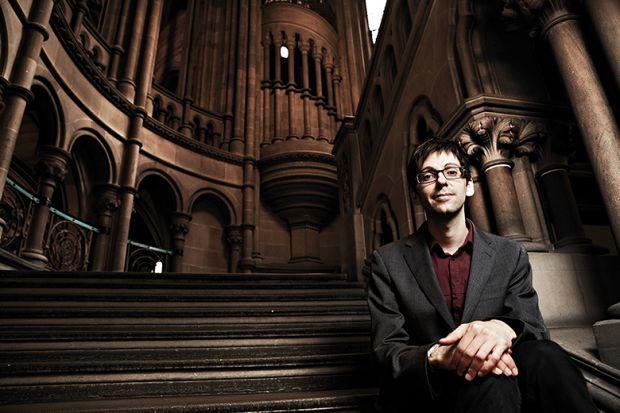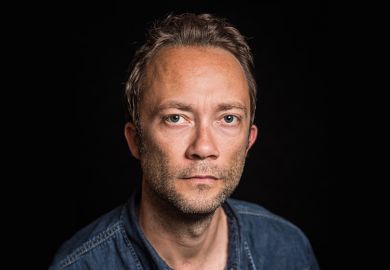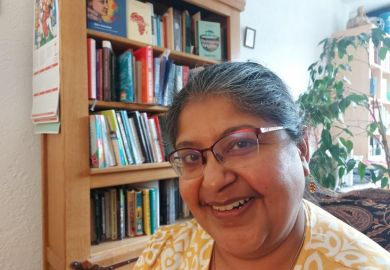Xavier Aldana Reyes, senior lecturer in English literature and film at Manchester Metropolitan University, is a founding member of the Manchester Centre for Gothic Studies. After studying English philology at the Autonomous University of Barcelona, he went on to do a master’s at Birkbeck, University of London and then a PhD at Lancaster University, where he also worked as an associate lecturer before joining Manchester Met in 2013. He has recently edited The Weird Tales of William Hope Hodgson and is working on two further volumes in the British Library’s Tales of the Weird series: Roarings from Further Out: Four Weird Novellas by Algernon Blackwood and Promethean Horrors: Classic Tales of Mad Science.
Where and when were you born?
I was born in Barcelona in 1984 but was not raised in that city. My hometown is a small, sleepy commuter town called Mollet del Vallès.
How has this shaped you?
Mollet is a lovely place if you are retired or are after a quiet and secluded life. As soon as I discovered my passion for English history, culture and literature (especially after a school trip to the UK), I knew I would end up leaving.
What was your most memorable moment at university?
The defining moment was an Erasmus trip in my fourth year, because I never came back.
When did you develop a passion for the Gothic?
I have always been interested in horror literature. It began with R. L. Stine’s Goosebumps series – I distinctly remember my dad admonishing me for buying Say Cheese and Die! because he was certain I would not be able to sleep that night – and it continued with Stephen King, Poppy Z. Brite, H. P. Lovecraft and Clive Barker, my teenage obsessions. It was only at university, however, during my MA, that I discovered “Gothic” as a critical term. It was a conglomeration of all the things I found interesting. I have never dressed according to goth fashion(s), but I have always been drawn to the dark side of art.
Are Spanish and British universities equally open to work in this field?
I am not sure the Gothic is widely taught in Spain beyond individual specialist units or as part of larger ones (in, say, Victorian literature). To my knowledge, the UK is the only country in Europe to offer specialist provision on the Gothic at MA level, and Manchester Metropolitan is one of only three universities to do so.
What were the other main things you noticed in moving to the UK?
The class system was the one that hit me the hardest. I still struggle with getting my surnames understood (“Dr Aldana Reyes”, not “Dr Reyes” or “Dr Aldana-Reyes”). Everyone has two surnames in Spain, so we do not hyphenate or double-barrel them.
Why is ‘the Gothic’ worthy of serious attention?
The Gothic allows us to explore the tensions between the modern and the antiquated, as well as what we now perceive as oppressive, even repressive, social and ideological (power) structures…In its wider meaning as the dark side of culture, it is always important and relevant. It is about this thing of darkness that we acknowledge ours, to misquote one of the greats.
What can we learn from ‘tales of mad science’?
Mad scientists are such a key figure in the Gothic canon. They are individuals who have sights larger than society, larger maybe than their feats can even accomplish. Mad scientists represent the best in us: our visions for a different future, an idea of progress that goes beyond existing limitations, our wildest dreams. They also represent the worst in us: our worst delusions, our pervasive obsessions, our incapacity to accept the ravages of time.
What claims would you make for the writers you are rescuing from neglect?
For me, they are the horror writers of the secular age. Their horrors are concerned with the numinous, with the material and with the limits of human perception, all of which have returned in philosophy in recent years.
Is ‘the Gothic imagination’ still alive and well today?
We have embraced a broader definition that understands the Gothic as the dark side of culture, as our Mr Hyde. And we all know that Hyde always wins this particular battle. As shown in the collection I recently edited with Maisha Wester, Twenty-First-Century Gothic: An Edinburgh Companion, the Gothic is certainly alive and kicking today in many countries.
If you were a prospective student now facing £9,000-plus tuition fees, would you go again or go straight into work?
I really could not conceive of a life without higher education. The most important thing [that university taught me was] how to be an independent thinker, how to contrast information, to work out what I really do think and why. In times of populism and fake news, this is one of the most valuable skills for life in general.
Tell us about someone you’ve always admired.
My ex-supervisor, Catherine Spooner. She was (and continues to be) a gentle, supportive, intellectually engaged, high-calibre academic. When I gave my first paper (a terrible one) at the very imposing Strawberry Hill [the Gothic villa built by Horace Walpole in the 18th century], she came over to talk to me and told me that she believed in what I wanted to do. I was living in London at the time, so I gave everything up to go and study with her at Lancaster.
Do you live by any motto or philosophy?
Not really, but since I am a pessimist at heart, I would have to say: “A pessimist is never disappointed.”
matthew.reisz@timeshighereducation.com
Appointments
Stacey Bent has been named vice-provost for graduate education and postdoctoral affairs at Stanford University. She is currently senior associate dean for faculty and academic affairs and Jagdeep and Roshni Singh professor in Stanford’s School of Engineering. When she takes up her new position on 1 September, Professor Bent will replace Patricia Gumport, who is returning to her post as director of the Stanford Institute for Higher Education Research. Professor Bent said she was “thrilled to have the opportunity to represent Stanford’s graduate student and postdoctoral community”.
Laurie Butler has joined Anglia Ruskin University as the dean of the Faculty of Science and Engineering and as a pro vice-chancellor. Professor Butler joins the institution from the University of Reading, where he led the School of Psychology and Clinical Language Sciences. Professor Butler said one of his priorities was to tackle the shortfall in science, technology, engineering and mathematics graduates in East Anglia. “I want us to build on excellent work already under way at Anglia Ruskin to ensure that far more women and other under-represented groups train to become the engineers, architects, computer scientists and scientists of tomorrow,” he said.
Brigitte Scammell has been appointed the new dean of the School of Medicine at the University of Nottingham. Professor Scammell, who will succeed Tony Avery in the role when he starts in August, is currently head of the division of rheumatology, orthopaedics and dermatology.
Frank Griffin has been confirmed as vice-chancellor of the University of Papua New Guinea. He has previously held management roles at the institution, including as executive dean of the School of Natural Sciences.
Kevin McDonald will be the new vice-president for diversity, equity and inclusion at the University of Virginia. He will join the institution in August from the University of Missouri-Columbia, where he is vice-chancellor for inclusion, diversity and equity.
Register to continue
Why register?
- Registration is free and only takes a moment
- Once registered, you can read 3 articles a month
- Sign up for our newsletter
Subscribe
Or subscribe for unlimited access to:
- Unlimited access to news, views, insights & reviews
- Digital editions
- Digital access to THE’s university and college rankings analysis
Already registered or a current subscriber? Login








